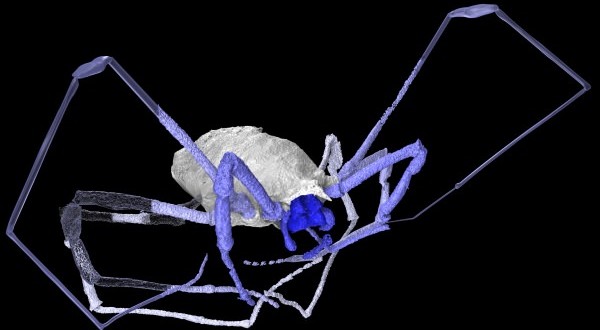Ancient spiders had two sets of eyes, according to a new fossil study.
The latest findings debunk the theory that 305-million-year-old harvestman- the ancestors of the modern-day arachnids- had two, not one, sets of eyes.
Researchers at the University of Manchester and American Museum of Natural History said the latest findings provide significant detail to the evolutionary story of this diverse and highly successful group of arthropods. Researchers said that spiders are found on every continent except Antarctica.
Press Releases
University of Manchester scientists, working with colleagues at the American Museum of Natural History, say the X-ray imaging techniques used have allowed them to reveal features of the unusually well-preserved fossil like never before.
The primitive fossilised harvestman, named Hastocularis argus, was found in eastern France and had not only median eyes – those found near the centre of the body – but lateral eyes on the side of the body as well.
“Although they have eight legs, harvestmen are not spiders; they are more closely related to another arachnid, the scorpion,” said author Dr Russell Garwood, a palaeontologist in the University of Manchester’s School of Earth, Atmospheric and Environmental Sciences.
“Arachnids can have both median and lateral eyes, but modern harvestmen only possess a single set of median eyes – and no lateral ones. These findings represent a significant leap in our understanding of the evolution of this group.”
The team supported their results by examining the expression of an ‘eye stalk’ gene in living harvestmen and found that in a modern harvestman embryo this gene shows hints of a now-lost lateral eye.
Co-author Prashant Sharma, a postdoctoral researcher at the American Museum of Natural History, said: “Terrestrial arthropods like harvestmen have a sparse fossil record because their exoskeletons don’t preserve well. As a result, some fundamental questions in the evolutionary history of these organisms remain unsolved.
“This exceptional fossil has given us a rare and detailed look at the anatomy of harvestmen that lived hundreds of millions of years ago. What we were also able to establish is that developing modern harvestmen embryos retain vestiges of eye-growth structures seen only in the fossil.”
Dr Garwood added: “Harvestmen fossils preserved in three dimensions are quite rare and our X-ray techniques have allowed us to reveal this exceptional fossil in more detail than we would have dreamed possible just a couple of decades ago.”
Press Releases/Canadajournal
 Canada Journal – News of the World Articles and videos to bring you the biggest Canadian news stories from across the country every day
Canada Journal – News of the World Articles and videos to bring you the biggest Canadian news stories from across the country every day



